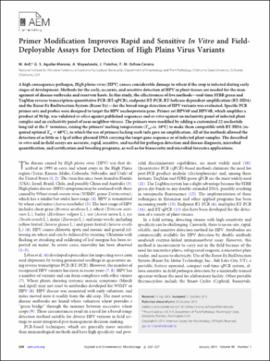| dc.contributor.author | Arif, M. | |
| dc.contributor.author | Aguilar-Moreno, G. S. | |
| dc.contributor.author | Wayadande, A. | |
| dc.contributor.author | Fletcher, J. | |
| dc.contributor.author | Ochoa-Corona, F. M. | |
| dc.date.accessioned | 2018-09-21T17:51:31Z | |
| dc.date.available | 2018-09-21T17:51:31Z | |
| dc.date.issued | 2014-01 | |
| dc.identifier | oksd_arif_primermodificat_2014 | |
| dc.identifier.citation | Arif, M., Aguilar-Moreno, G. S., Wayadande, A., Fletcher, J., & Ochoa-Corona, F. M. (2014). Primer modification improves rapid and sensitive in vitro and field-deployable assays for detection of High plains virus variants. Applied and Environmental Microbiology, 80(1), 320-327. https://doi.org/10.1128/AEM.02340-13 | |
| dc.identifier.uri | https://hdl.handle.net/11244/301755 | |
| dc.description.abstract | A high consequence pathogen, High plains virus (HPV) causes considerable damage to wheat if the crop is infected during early stages of development. Methods for the early, accurate, and sensitive detection of HPV in plant tissues are needed for the management of disease outbreaks and reservoir hosts. In this study, the effectiveness of five methods—real-time SYBR green and TaqMan reverse transcription-quantitative PCR (RT-qPCR), endpoint RT-PCR, RT-helicase dependent amplification (RT-HDA) and the Razor Ex BioDetection System (Razor Ex)—for the broad-range detection of HPV variants was evaluated. Specific PCR primer sets and probes were designed to target the HPV nucleoprotein gene. Primer set HPV6F and HPV4R, which amplifies a product of 96 bp, was validated in silico against published sequences and in vitro against an inclusivity panel of infected plant samples and an exclusivity panel of near-neighbor viruses. The primers were modified by adding a customized 22 nucleotide long tail at the 5′ terminus, raising the primers' melting temperature (Tm; ca. 10°C) to make them compatible with RT-HDA (required optimal Tm = 68°C), in which the use of primers lacking such tails gave no amplification. All of the methods allowed the detection of as little as 1 fg of either plasmid DNA carrying the target gene sequence or of infected plant samples. The described in vitro and in-field assays are accurate, rapid, sensitive, and useful for pathogen detection and disease diagnosis, microbial quantification, and certification and breeding programs, as well as for biosecurity and microbial forensics applications. | |
| dc.format | application/pdf | |
| dc.language | en_US | |
| dc.publisher | American Society for Microbiology | |
| dc.rights | This material has been previously published. In the Oklahoma State University Library's institutional repository this version is made available through the open access principles and the terms of agreement/consent between the author(s) and the publisher. The permission policy on the use, reproduction or distribution of the material falls under fair use for educational, scholarship, and research purposes. Contact Digital Resources and Discovery Services at lib-dls@okstate.edu or 405-744-9161 for further information. | |
| dc.title | Primer modification improves rapid and sensitive in vitro and field-deployable assays for detection of High plains virus variants | |
| osu.filename | oksd_arif_primermodificat_2014.pdf | |
| dc.description.peerreview | Peer reviewed | |
| dc.identifier.doi | 10.1128/AEM.02340-13 | |
| dc.description.department | Entomology and Plant Pathology | |
| dc.type.genre | Article | |
| dc.type.material | Text | |
| dc.subject.keywords | nucleoproteins | |
| dc.subject.keywords | nucleotides | |
| dc.subject.keywords | reverse transcription | |
| dc.subject.keywords | freezing | |
| dc.subject.keywords | plasmids | |
| dc.subject.keywords | temperature | |
| dc.subject.keywords | genes | |
